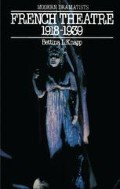Abstract
Fernand Crommelynck’s theatre is neither a civic festival nor a morality lesson, nor is it designed for relaxation. It is a theatre of action, of psychological probings, of character evolution, of dramatic climaxes, and of shattering suspense scenes. The bizarre machinations of his protagonists, their instinctuality and crudeness, bring to mind the seventeenth-century farceurs. The young Molière, it has been claimed, was attracted to the Pont Neuf to observe the antics and verbal routines of the famous Tabarin, who would abash his viewers with his exaggerated visual and auditive compositions. Crommelynck captures the rudimentary temperament of the farceur in The Magnificent Cuckold (Le Cocu magnifique, 1920) and Golden Tripe (Tripes d’Or, 1925); and the lithe and imaginative quality of the commedia dell’arte plays with their improvisations and stock characters in Carine (1929); the hermetic implications of the mask in The Sculptor of Masks (Le Sculpteur de Masques, 1911); the symbolic and illusory realm in The Puerile Lovers (Les Amants puérils, 1921); the more popular blends of boulevard theatre in Hot and Cold (Chaud et Froid, 1934) and A Woman Whose Heart is too Small (La Femme qu’a le coeur trop petit, 1934).
Preview
Unable to display preview. Download preview PDF.
Author information
Authors and Affiliations
Copyright information
© 1985 Bettina L. Knapp
About this chapter
Cite this chapter
Knapp, B.L. (1985). Fernand Crommelynck (1886–1970). In: French Theatre 1918–1939. Macmillan Modern Dramatists. Palgrave, London. https://doi.org/10.1007/978-1-349-17985-5_6
Download citation
DOI: https://doi.org/10.1007/978-1-349-17985-5_6
Publisher Name: Palgrave, London
Print ISBN: 978-0-333-37259-3
Online ISBN: 978-1-349-17985-5
eBook Packages: Palgrave Literature & Performing Arts CollectionLiterature, Cultural and Media Studies (R0)

